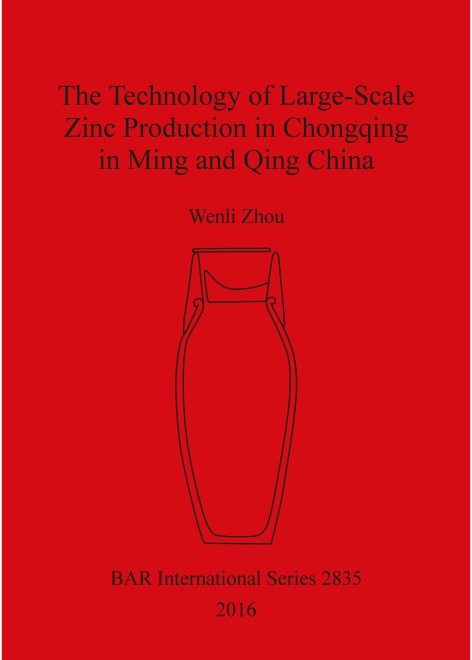- The Technology of Large-Scale Zinc Production in Chongqing in Ming and Qing China

The Technology of Large-Scale Zinc Production in Chongqing in Ming and Qing China was the PhD dissertation finished by Wenli Zhou in UCL in 2012. It was revised and published by BAR Publishing in December, 2016. The book for the first time reconstructed the technological process of zinc distillation in ancient China in high-resolution through archaeological work of zinc smelting sites and scientific analyses of production remains, and discussed technological differences of zinc smelting workshops from different periods in Chongqing and their reasons.
Zinc was one of the important metals in the ancient world, primarily as an essential component of the alloy brass. As a volatile metal, its production required sophisticated distillation installations. The production of this metal played a special role in both the technological and economic history of Ming and Qing China: zinc was employed for coinage and also exported to the world via maritime trade. Since the early twentieth century, many scholars have studied the history of Chinese zinc smelting technology based on evidence from historical records, ancient brass coins and traditional zinc smelting processes. A major gap in our understanding of ancient Chinese zinc production has been the lack of detailed technological reconstructions based on the study of ancient production remains. Recently excavated zinc production sites in Chongqing provide an excellent opportunity to address this issue.
This research presents the analyses, technical interpretation and socio-economic contextualisation of the production remains from three Ming sites in Fengdu (Miaobeihou, Puzihe and Muxiexi) and one Qing site in Shizhu (Dafengmen). Zinc ore, zinc metal, retorts and slag from these sites were analysed by OM, SEM-EDS, EPMA-WDS and XRD. The analytical results reveal that these sites used similar zinc distillation technology: the retorts were made of pots, condensers, pockets and lids, all well designed to meet specific performance characteristics; the pots were charged with iron-rich oxidic zinc ores, coal and charcoal; a high temperature of around 1200 °C and highly reducing atmosphere were achieved inside the pots to reduce the zinc ores; the zinc vapour formed within the pots ascended through the hole of pockets and was cooled and collected in the condensers. Some differences were found between two groups of sites. The Qing site used lower grade oxidic zinc ores, a lower proportion of reducing agents, and elongated retorts of inferior performance, leading to a lower technical efficiency, in spite of its ideal location near the necessary resources of zinc ores and coal. These differences can be explained as adaptation of the zinc production for coinage to the different social, political and economic constraints affecting these sites.
This research thus offers a first contribution towards a detailed reconstruction of Chinese zinc distillation technology that considers both variations in time and space as well as common elements that characterise the Chinese technological style. Finally, the significance of Chinese zinc production is contextualised and discussed with reference to coinage in Ming and Qing China, but also by comparing it to other brass and zinc making technologies in China, India and Europe, and by assessing the influence of Chinese zinc in global maritime trade.
Contents
Chapter 1 Introduction
1.1 A brief history of the metallurgy of zinc and brass
1.2 Problems and research gaps in the study of Chinese zinc distillation technology
1.3 Research aims and objectives
1.4 Structure of the research
Chapter 2 Historical and Technological Background to Zinc Production in China
2.1 The history of brass and zinc in China
2.2 The uses of brass and zinc in Ming and Qing China
2.3 Traditional zinc smelting in modern China
2.4 Summary
Chapter 3 Theoretical Framework and Methodology
3.1 Theoretical framework
3.2 Methodology
Chapter 4 Analyses of Zinc Smelting Remains in Fengdu
4.1 Zinc smelting sites in Fengdu
4.2 Miaobeihou
4.3 Puzihe and Muxiexi
4.4 Zinc production in Fengdu
Chapter 5 Analyses of Zinc Smelting Remains in Shizhu
5.1 Zinc mines and smelting sites in Shizhu
5.2 Yushi Cave
5.3 Dafengmen
5.4 Discussion
Chapter 6 Zinc Production in Chongqing and Beyond
6.1 Zinc smelting sites in Fengdu and Shizhu: a comparison
6.2 The technological tradition of Chinese zinc distillation
6.3 Zinc distillation in India and China
6.4 Summary
Chapter 7 The Significance of Zinc Production in Ming and Qing China
7.1 Chinese zinc at home
7.2 Chinese zinc in the world
Chapter 8 Conclusions and Future Work
8.1 Zinc smelting in Chongqing and beyond
8.2 Zinc distillation, crucible smelting and technical ceramics
8.3 On the origins of zinc distillation in China
8.4 History, archaeology, science and ethnography




